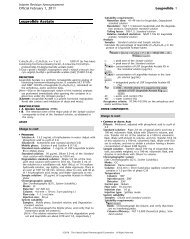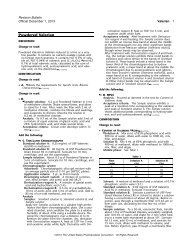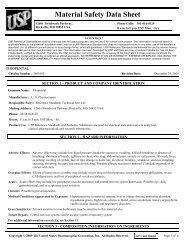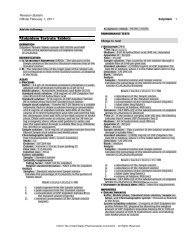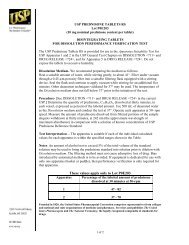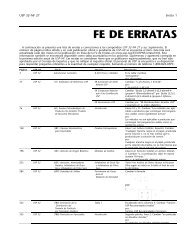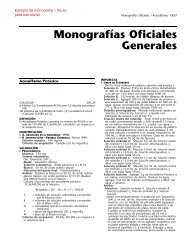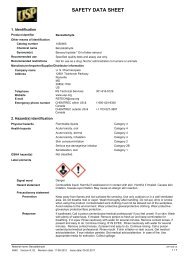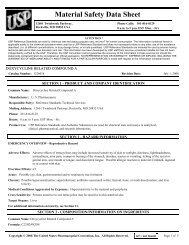SAFETY DATA SHEET - US Pharmacopeial Convention
SAFETY DATA SHEET - US Pharmacopeial Convention
SAFETY DATA SHEET - US Pharmacopeial Convention
Create successful ePaper yourself
Turn your PDF publications into a flip-book with our unique Google optimized e-Paper software.
1. Identification<br />
<strong>SAFETY</strong> <strong>DATA</strong> <strong>SHEET</strong><br />
Product identifier Tacrolimus<br />
Other means of identification<br />
Catalog number 1642802<br />
Chemical name 15,19-Epoxy-3H-pyrido[2,1-c][1,4]oxaazacyclotricosine-1,7,20,21(4H,23H)-tetrone,<br />
5,6,8,11,12,13,14,15,16,17,18,19,24,25,26,26a-hexadecahydro-5,19-dihydroxy-3-[2-(4-hydroxy-3-m<br />
monohydrate,<br />
[3S-[3R*,[E(1S*,3S*,4S*)],4S*,5R*,8S*,9E,12R*,14R*,15S*,16R*,18S*,19S*,26aR*]]-<br />
Recommended use Specified quality tests and assay use only.<br />
Recommended restrictions Not for use as a drug. Not for administration to humans or animals.<br />
Manufacturer/Importer/Supplier/Distributor information<br />
Company name<br />
U. S. Pharmacopeia<br />
Address<br />
12601 Twinbrook Parkway<br />
Rockville<br />
MD<br />
20852-1790<br />
<strong>US</strong><br />
Telephone RS Technical Services 301-816-8129<br />
Website<br />
www.usp.org<br />
E-mail RSTECH@usp.org<br />
Emergency phone number CHEMTREC within <strong>US</strong> &<br />
Canada<br />
CHEMTREC outside <strong>US</strong> &<br />
Canada<br />
2. Hazard(s) identification<br />
Physical hazards<br />
Health hazards<br />
OSHA hazard(s)<br />
Label elements<br />
Not classified.<br />
Acute toxicity, oral<br />
Serious eye damage/eye irritation<br />
Specific target organ toxicity, repeated<br />
exposure<br />
Not classified.<br />
1-800-424-9300<br />
+1 703-527-3887<br />
Category 3<br />
Category 2B<br />
Category 1 (Immune system)<br />
Signal word Danger<br />
Hazard statement Toxic if swallowed. Causes eye irritation. Causes damage to organs (Immune system) through<br />
prolonged or repeated exposure.<br />
Precautionary statement<br />
Prevention Wash thoroughly after handling. Do not eat, drink or smoke when using this product.<br />
Response If in eyes: Rinse cautiously with water for several minutes. Remove contact lenses, if present and<br />
easy to do. Continue rinsing. Get medical advice/attention if you feel unwell. Rinse mouth. If eye<br />
irritation persists: Get medical advice/attention.<br />
Storage Store locked up.<br />
Disposal Dispose of contents/container to an approved disposal site.<br />
Hazard(s) not otherwise Not classified.<br />
classified (HNOC)<br />
3. Composition/information on ingredients<br />
Substance<br />
Material name: Tacrolimus<br />
7331 Version #: 02 Revision date: 12-07-2012 Issue date: 01-21-2008<br />
<strong>US</strong>P SDS <strong>US</strong><br />
1 / 7
Hazardous components<br />
Chemical name Common name and synonyms<br />
CAS number %<br />
Tacrolimus 109581-93-3<br />
100<br />
4. First-aid measures<br />
Inhalation Move to fresh air. Call a physician if symptoms develop or persist.<br />
Skin contact Rinse skin with water/shower. Get medical attention if irritation develops and persists.<br />
Eye contact Rinse cautiously with water for several minutes. Get medical attention if irritation develops and<br />
persists.<br />
Ingestion Call a physician or poison control center immediately. Rinse mouth thoroughly. Do not induce<br />
vomiting without advice from poison control center. If vomiting occurs, keep head low so that<br />
stomach content doesn't get into the lungs. Do not use mouth-to-mouth method if victim ingested<br />
the substance.<br />
Most important<br />
Irritation of eyes and mucous membranes. Prolonged exposure may cause chronic effects.<br />
symptoms/effects, acute and<br />
delayed<br />
Indication of immediate<br />
medical attention and special<br />
treatment needed<br />
Provide general supportive measures and treat symptomatically. Do not induce vomiting.<br />
Administer activated charcoal as a slurry. Perform gastric lavage. For protection of airways, place<br />
in Trendelenburg and left lateral decubitus position or by endotracheal intubation. Control any<br />
seizures first. Correct magnesium deficits. For seizures, administer intravenous diazepam or<br />
lorazapam. If seizures occur, give phenobarbital. Monitor for hypotension, dysrhythmias,<br />
respiratory depression, and need for endotracheal intubation. Evaluate for hypoglycemia,<br />
electrolyte disturbances, and hypoxia. For hypertension and tachycardia, administer with<br />
benzodiazepines. For severe hypertension, nitroprusside is preferred; labetalol, nitroglycerin, and<br />
phentolamine are alternatives. Dialysis will not effectively remove this material. (Meditext) (<strong>US</strong>P<br />
DI)<br />
General information Remove from exposure. Remove contaminated clothing. For treatment advice, seek guidance<br />
from an occupational health physician or other licensed health-care provider familiar with<br />
workplace chemical exposures. In the United States, the national poison control center phone<br />
number is 1-800-222-1222. If person is not breathing, give artificial respiration. If breathing is<br />
difficult, give oxygen if available. Persons developing serious hypersensitivity (anaphylactic)<br />
reactions must receive immediate medical attention.<br />
5. Fire-fighting measures<br />
Suitable extinguishing media Water spray, dry chemical, carbon dioxide, or foam as appropriate for surrounding fire and<br />
materials.<br />
Unsuitable extinguishing None known.<br />
media<br />
Specific hazards arising from No unusual fire or explosion hazards noted.<br />
the chemical<br />
Special protective equipment Wear suitable protective equipment.<br />
and precautions for firefighters<br />
Fire-fighting<br />
equipment/instructions<br />
As with all fires, evacuate personnel to a safe area. Firefighters should use self-contained<br />
breathing equipment and protective clothing.<br />
Specific methods Cool containers exposed to flames with water until well after the fire is out.<br />
6. Accidental release measures<br />
Personal precautions,<br />
protective equipment and<br />
emergency procedures<br />
Methods and materials for<br />
containment and cleaning up<br />
7. Handling and storage<br />
Keep unnecessary personnel away. Do not touch damaged containers or spilled material unless<br />
wearing appropriate protective clothing. Ensure adequate ventilation. Avoid inhalation of dust from<br />
the spilled material. Wear appropriate personal protective equipment.<br />
Sweep up or vacuum up spillage and collect in suitable container for disposal. Avoid the<br />
generation of dusts during clean-up. For waste disposal, see section 13 of the SDS. Wash spill<br />
site.<br />
Precautions for safe handling As a general rule, when handling <strong>US</strong>P Reference Standards, avoid all contact and inhalation of<br />
dust, mists, and/or vapors associated with the material. Clean equipment and work surfaces with<br />
suitable detergent or solvent after use. After removing gloves, wash hands and other exposed<br />
skin thoroughly. Use of a designated area is recommended for handling of potent materials.<br />
Conditions for safe storage,<br />
including any incompatibilities<br />
Material name: Tacrolimus<br />
7331 Version #: 02 Revision date: 12-07-2012 Issue date: 01-21-2008<br />
Store in tight container as defined in the <strong>US</strong>P-NF. This material should be handled and stored per<br />
label instructions to ensure product integrity.<br />
<strong>US</strong>P SDS <strong>US</strong><br />
2 / 7
8. Exposure controls/personal protection<br />
Exposure limit values<br />
Industrial Use<br />
Material Type<br />
Value<br />
Tacrolimus (CAS<br />
109581-93-3)<br />
TWA 0.2 micrograms/m3<br />
Biological limit values No biological exposure limits noted for the ingredient(s).<br />
Appropriate engineering Airborne exposure should be controlled primarily by engineering controls such as general dilution<br />
controls<br />
ventilation, local exhaust ventilation, or process enclosure. Local exhaust ventilation is generally<br />
preferred to general exhaust because it can control the contaminant at its source, preventing<br />
dispersion into the work area. An industrial hygiene survey involving air monitoring may be used<br />
to determine the effectiveness of engineering controls. Effectiveness of engineering controls<br />
intended for use with highly potent materials should be assessed by use of nontoxic surrogate<br />
materials.<br />
Avoid any open handling of this material, particularly for grinding, crushing, weighing or other<br />
dust-generating or aerosol-generating procedures. Use a laboratory fume hood, vented enclosure,<br />
glovebox, or other effective containment.<br />
Individual protection measures, such as personal protective equipment<br />
Eye/face protection<br />
Skin protection<br />
Safety glasses with sideshields are recommended. Face shields or goggles may be required if<br />
splash potential exists or if corrosive materials are present. Approved eye protection (e.g., bearing<br />
the ANSI Z87 or CSA stamp) is preferred. Maintain eyewash facilities in the work area.<br />
Hand protection Chemically compatible gloves. For handling solutions, ensure that the glove material is protective<br />
against the solvent being used. Use handling practices that minimize direct hand contact.<br />
Employees who are sensitive to natural rubber (latex) should use nitrile or other synthetic nonlatex<br />
gloves. Use of powdered latex gloves should be avoided due to the risk of latex allergy. This<br />
material is extremely potent. To reduce the risk of contamination of skin and surfaces, wear two<br />
pairs of gloves. Remove the outer gloves after handling and cleanup of the material, and remove<br />
the inner gloves only after removing other personal protective equipment.<br />
Other For handling of laboratory scale quantities, a disposable lab coat or isolation gown over street<br />
clothes is recommended. Where significant quantities are handled, work clothing and booties may<br />
be necessary to prevent take-home contamination.<br />
Respiratory protection Where respirators are deemed necessary to reduce or control occupational exposures, use<br />
NIOSH-approved respiratory protection and have an effective respirator program in place<br />
(applicable U.S. regulation OSHA 29 CFR 1910.134).<br />
Thermal hazards Not available.<br />
General hygiene<br />
considerations<br />
Handle in accordance with good industrial hygiene and safety practice.<br />
9. Physical and chemical properties<br />
Appearance White crystalline powder.<br />
Physical state Solid.<br />
Form Powder.<br />
Odor Not available.<br />
Odor threshold Not available.<br />
pH Not available.<br />
Melting point/freezing point 260.6 - 271.4 °F (127 - 133 °C)<br />
Initial boiling point and boiling<br />
range<br />
Not available.<br />
Flash point Not available.<br />
Evaporation rate Not available.<br />
Flammability (solid, gas) Not applicable.<br />
Upper/lower flammability or explosive limits<br />
Flammability limit - lower<br />
(%)<br />
Not available.<br />
Flammability limit - upper<br />
(%)<br />
Not available.<br />
Explosive limit - lower (%) Not available.<br />
Explosive limit - upper (%) Not available.<br />
Vapor pressure Not available.<br />
Vapor density Not available.<br />
Material name: Tacrolimus<br />
7331 Version #: 02 Revision date: 12-07-2012 Issue date: 01-21-2008<br />
<strong>US</strong>P SDS <strong>US</strong><br />
3 / 7
Relative density Not available.<br />
Solubility in water Insoluble.<br />
Partition coefficient<br />
(n-octanol/water)<br />
Not available.<br />
Auto-ignition temperature Not available.<br />
Decomposition temperature Not available.<br />
Viscosity<br />
Other information<br />
Not available.<br />
Chemical family Macrolide.<br />
Molecular formula C44H69NO12 . H2O<br />
Molecular weight 822.03<br />
Solubility (other) Freely soluble in ethanol; very soluble in methanol; soluble in acetone, in ethyl acetate, in<br />
chloroform, and in diethyl ether; sparingly soluble in hexane and in petroleum ether.<br />
10. Stability and reactivity<br />
Reactivity No reactivity hazards known.<br />
Chemical stability Stable at normal conditions.<br />
Possibility of hazardous<br />
reactions<br />
No dangerous reaction known under conditions of normal use.<br />
Conditions to avoid None under normal conditions.<br />
Incompatible materials Strong oxidizing agents.<br />
Hazardous decomposition<br />
products<br />
NOx. Irritating and/or toxic fumes or gases. Emits toxic fumes under fire conditions.<br />
11. Toxicological information<br />
Information on likely routes of exposure<br />
Ingestion Toxic if swallowed.<br />
Inhalation Due to lack of data the classification is not possible.<br />
Skin contact Due to lack of data the classification is not possible.<br />
Eye contact Causes eye irritation.<br />
Symptoms related to the Nausea. Diarrhea. Muscle pain. Dizziness. Difficulty sleeping. Rash. Itching. Trembling.<br />
physical, chemical, and<br />
toxicological characteristics<br />
Headache. Numbness or tingling of skin. Joint pain.<br />
Delayed and immediate effects<br />
of exposure<br />
High blood pressure. Kidney damage. Seizures. Delirium. Immunosuppression. Coma.<br />
Chronic effects Causes damage to organs through prolonged or repeated exposure.<br />
Medical conditions aggravated<br />
by exposure<br />
Netherton's syndrome. Impaired kidney function: Impaired liver function.<br />
Acute toxicity Toxic if swallowed.<br />
Product<br />
Tacrolimus (CAS 109581-93-3)<br />
Oral<br />
Species<br />
Test Results<br />
LD50 Mouse<br />
134 mg/kg, (male)<br />
Skin corrosion/irritation Based on available data, the classification criteria are not met.<br />
Serious eye damage/eye Causes eye irritation.<br />
irritation<br />
Local effects<br />
Irritancy test<br />
Result: Irritant.<br />
Species: Rabbit<br />
Organ: Eye.<br />
Irritancy test<br />
Result: Non-Irritant.<br />
Species: Rabbit<br />
Organ: Skin.<br />
Respiratory sensitization Due to lack of data the classification is not possible.<br />
Skin sensitization Due to lack of data the classification is not possible.<br />
Germ cell mutagenicity Based on available data, the classification criteria are not met.<br />
Material name: Tacrolimus<br />
7331 Version #: 02 Revision date: 12-07-2012 Issue date: 01-21-2008<br />
<strong>US</strong>P SDS <strong>US</strong><br />
4 / 7
Mutagenicity<br />
E. coli<br />
Result: Negative.<br />
In vitro CHO/HGPRT assay<br />
Result: Negative.<br />
In vitro Chinese hamster lung-derived cells assay<br />
Result: Negative.<br />
In vivo clastogenicity assay<br />
Result: Negative.<br />
Species: Mouse<br />
S. typhimurium Ames assay<br />
Result: Negative.<br />
Carcinogenicity This product is not considered to be a carcinogen by IARC, ACGIH, NTP, or OSHA.<br />
1.1 - 111 mg/kg/day Carcinogenicity study (tacrolimus<br />
ointment)<br />
Result: Incidence of skin tumors was minimal.<br />
Species: Mouse<br />
Test Duration: 104 weeks<br />
3 mg/kg Carcinogenicity study<br />
Result: No relationship between tumor incidence and dosage.<br />
Species: Mouse<br />
Test Duration: 80 weeks<br />
3.5 mg/kg Carcinogenicity study (dermal)<br />
Result: Lymphomas were noted (0.1% tacrolimus ointment).<br />
Species: Mouse<br />
5 mg/kg Carcinogenicity study<br />
Result: No relationship between tumor incidence and dosage.<br />
Species: Rat<br />
Test Duration: 104 weeks<br />
Photocarcinogenicity study<br />
Result: Time to onset skin tumor formation was decreased.<br />
Species: Mouse<br />
Test Duration: 40 weeks<br />
Reproductive toxicity Based on available data, the classification criteria are not met.<br />
Reproductivity<br />
0.32 - 1 mg/kg Reproductivity test<br />
Result: Maternal toxicity observed; increased incidence of<br />
abortions.<br />
Species: Rabbit<br />
1 - 3.2 mg/kg Reproductivity test<br />
Result: Reduced pup weights.<br />
Species: Rat<br />
3.2 mg/kg Reproductivity test<br />
Result: Maternal toxicity observed; increase in late<br />
resorptions; decreased number of live births; decreased pup<br />
weight and viability.<br />
Species: Rat<br />
Specific target organ toxicity - Due to lack of data the classification is not possible.<br />
single exposure<br />
Specific target organ toxicity - Causes damage to organs (Immune system) through prolonged or repeated exposure.<br />
repeated exposure<br />
Aspiration hazard Based on available data, the classification criteria are not met.<br />
12. Ecological information<br />
Ecotoxicity No ecotoxicity data noted for the ingredient(s).<br />
Persistence and degradability No data is available on the degradability of this product.<br />
Bioaccumulative potential Not available.<br />
Mobility in soil Not available.<br />
Other adverse effects Not available.<br />
13. Disposal considerations<br />
Disposal instructions This product, in its present state, when discarded or disposed of, is not a hazardous waste<br />
according to Federal regulations (40 CFR 261.4 (b)(4)). Under RCRA, it is the responsibility of<br />
the user of the product to determine, at the time of disposal, whether the product meets RCRA<br />
criteria for hazardous waste. Dispose in accordance with all applicable regulations.<br />
Local disposal regulations Not available.<br />
Hazardous waste code Not regulated.<br />
Material name: Tacrolimus<br />
7331 Version #: 02 Revision date: 12-07-2012 Issue date: 01-21-2008<br />
<strong>US</strong>P SDS <strong>US</strong><br />
5 / 7
Waste from residues / unused<br />
products<br />
Empty containers or liners may retain some product residues. This material and its container must<br />
be disposed of in a safe manner (see: Disposal instructions).<br />
Contaminated packaging Empty containers should be taken to an approved waste handling site for recycling or disposal.<br />
Since emptied containers may retain product residue, follow label warnings even after container is<br />
emptied.<br />
14. Transport information<br />
DOT<br />
UN number<br />
UN proper shipping name<br />
Transport hazard class(es)<br />
Subsidiary class(es)<br />
Packing group<br />
IATA<br />
UN number<br />
UN proper shipping name<br />
Transport hazard class(es)<br />
Subsidiary class(es)<br />
Packaging group<br />
Environmental hazards<br />
Transport in bulk according to<br />
Annex II of MARPOL 73/78 and<br />
the IBC Code<br />
DOT; IATA<br />
15. Regulatory information<br />
UN2811<br />
Toxic solid, organic, n.o.s. (Tacrolimus)<br />
6.1<br />
Not available.<br />
III<br />
UN2811<br />
Toxic solid, organic, n.o.s. (Tacrolimus)<br />
6.1<br />
-<br />
III<br />
No<br />
No information available.<br />
<strong>US</strong> federal regulations CERCLA/SARA Hazardous Substances - Not applicable.<br />
One or more components are not listed on TSCA.<br />
Superfund Amendments and Reauthorization Act of 1986 (SARA)<br />
Hazard categories Immediate Hazard - Yes<br />
Delayed Hazard - No<br />
Fire Hazard - No<br />
Pressure Hazard - No<br />
Reactivity Hazard - No<br />
SARA 302 Extremely<br />
hazardous substance<br />
No<br />
SARA 311/312 Hazardous<br />
chemical<br />
Other federal regulations<br />
No<br />
Safe Drinking Water Act<br />
(SDWA)<br />
Not regulated.<br />
Food and Drug<br />
Administration (FDA)<br />
Not regulated.<br />
<strong>US</strong> state regulations<br />
International Inventories<br />
California Safe Drinking Water and Toxic Enforcement Act of 1986 (Proposition 65): This material<br />
is not known to contain any chemicals currently listed as carcinogens or reproductive toxins.<br />
Country(s) or region Inventory name On inventory (yes/no)*<br />
Australia Australian Inventory of Chemical Substances (AICS)<br />
No<br />
Canada Domestic Substances List (DSL)<br />
No<br />
Canada Non-Domestic Substances List (NDSL)<br />
No<br />
China Inventory of Existing Chemical Substances in China (IECSC)<br />
No<br />
Europe European Inventory of Existing Commercial Chemical<br />
Substances (EINECS)<br />
No<br />
Material name: Tacrolimus<br />
7331 Version #: 02 Revision date: 12-07-2012 Issue date: 01-21-2008<br />
<strong>US</strong>P SDS <strong>US</strong><br />
6 / 7
Country(s) or region Inventory name On inventory (yes/no)*<br />
Europe European List of Notified Chemical Substances (ELINCS)<br />
No<br />
Japan Inventory of Existing and New Chemical Substances (ENCS)<br />
No<br />
Korea Existing Chemicals List (ECL)<br />
No<br />
New Zealand New Zealand Inventory<br />
No<br />
Philippines Philippine Inventory of Chemicals and Chemical Substances<br />
(PICCS)<br />
United States & Puerto Rico Toxic Substances Control Act (TSCA) Inventory<br />
*A "Yes" indicates that all components of this product comply with the inventory requirements administered by the governing country(s)<br />
16. Other information, including date of preparation or last revision<br />
Issue date 01-21-2008<br />
Revision date 12-07-2012<br />
Version # 02<br />
Further information Not available.<br />
Disclaimer <strong>US</strong>P Reference Standards are sold for chemical test and assay purposes only, and NOT for<br />
human consumption. The information contained herein is applicable solely to the chemical<br />
substance when used as a <strong>US</strong>P Reference Standard and does not necessarily relate to any other<br />
use of the substance described, (i.e. at different concentrations, in drug dosage forms, or in bulk<br />
quantities). <strong>US</strong>P Reference Standards are intended for use by persons having technical skill and<br />
at their own discretion and risk. This information has been developed by <strong>US</strong>P staff from sources<br />
considered reliable but has not been independently verified by the <strong>US</strong>P. Therefore, the <strong>US</strong>P<br />
<strong>Convention</strong> cannot guarantee the accuracy of the information in these sources nor should the<br />
statements contained herein be considered an official expression. NO REPRESENTATION OR<br />
WARRANTY, EXPRESS OR IMPLIED, INCLUDING THE WARRANTIES OF MERCHANTABILITY<br />
AND FITNESS FOR A PARTICULAR PURPOSE is made with respect to the information<br />
contained herein.<br />
Revision Information This document has undergone significant changes and should be reviewed in its entirety.<br />
Material name: Tacrolimus<br />
7331 Version #: 02 Revision date: 12-07-2012 Issue date: 01-21-2008<br />
No<br />
No<br />
<strong>US</strong>P SDS <strong>US</strong><br />
7 / 7




